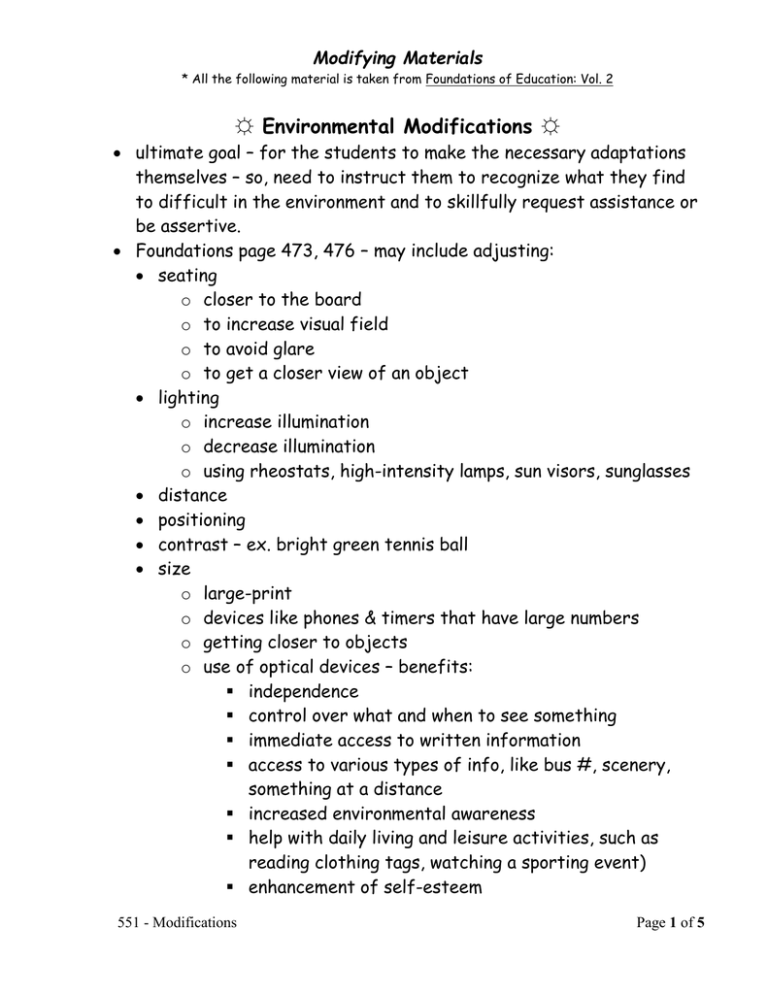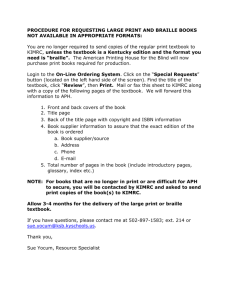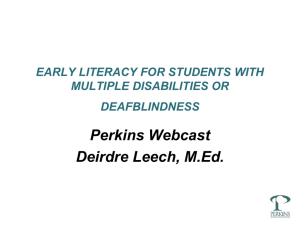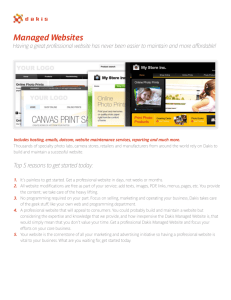Notes on modifying materials
advertisement

Modifying Materials * All the following material is taken from Foundations of Education: Vol. 2 ☼ Environmental Modifications ☼ ultimate goal – for the students to make the necessary adaptations themselves – so, need to instruct them to recognize what they find to difficult in the environment and to skillfully request assistance or be assertive. Foundations page 473, 476 – may include adjusting: seating o closer to the board o to increase visual field o to avoid glare o to get a closer view of an object lighting o increase illumination o decrease illumination o using rheostats, high-intensity lamps, sun visors, sunglasses distance positioning contrast – ex. bright green tennis ball size o large-print o devices like phones & timers that have large numbers o getting closer to objects o use of optical devices – benefits: independence control over what and when to see something immediate access to written information access to various types of info, like bus #, scenery, something at a distance increased environmental awareness help with daily living and leisure activities, such as reading clothing tags, watching a sporting event) enhancement of self-esteem 551 - Modifications Page 1 of 5 increase options for employment reduced costs over LP books reduced time (not having to wait for LP papers) may be able to learn to drive and get driver’s license with bioptic telescopic systems to make visual tasks easier and to reduce visual fatigue o bold-line paper o typoscope (a black piece of paper or plastic with a window cut out of it to isolate a single portion of printed material at a time) o yellow acetate overlay to increase print contrast For more GREAT information: pp 477 - 478 – describe different types and uses of low vision devices. p 479 – describes pros and cons of optical devices and large print p 481 – describes advantages of different mounting systems pp 444 - 445 – list common mods for physical activities ☼ Instructional Materials Modifications ☼ The modifying process: 1. Identify the primary goal of the assignment 2. Figure out a way for the student to respond to that primary goal. p 177 – Stratton’s Hierarchy for Adapting Materials: “Adapted materials should serve as a means to an end…should be a way to build skills that will be a bridge toward learning in the natural environment.” “To adapt more than is necessary separates the child from the environment; to adapt less may inhibit learning” recommends that the teacher focuses on the student’s ability to use regular materials first 1. Full learning from the environment: student doesn’t need any special adaptations to learn from the natural environment least intrusive 551 - Modifications Page 2 of 5 allows full participation in regular activities with standard materials 2. Mediate: learn from the environment teacher assists as student uses natural learning materials 3. Adapt: means to end teacher needs to adapt materials as a means of developing skills to later be used in the natural environment 4. Replace: standard materials are complete replaced with adapted materials most intrusive Materials – Your Tool Kit o Just as you need a FVLMA testing kit, you need a tool kit for working with your academic students. Koenig and Holbrook: “toolbox” of range of options that may be needed for any one task. “A student who is able to perform a task only by using adapted materials is limited to the use of those materials.” Koenig & Holbrook suggest: bold-line paper CCTV felt-tip pens braille tests braille note takers handwriting keyboarding enlarged materials low vision devices live readers 551 - Modifications Page 3 of 5 Some more suggestions: Geotape – diff colors / widths Textures o paper (APH) o material scraps The little tactile concept books from Oakmont http://www.teachersaidsforblindchildren.org/products.html Braille labeler Braillon sticky back paper (APH) Index cards Dark #3 pencils Markers and scented markers One hole puncher or craft puncher Wiki sticks (APH) Stickers – tactile (APH) and scented Mini stapler kit Paperclips 3-hole puncher Scissors Reflective tape Magnetic tape / cookie sheet or place holder (APH) Tactile graphics kit (APH) pp 181- 182 – more modifications: visual adaptations photocopying using magnification devices increasing clarity and contrast 551 - Modifications Page 4 of 5 decreasing glare decreasing visual clutter tactile adaptations auditory adaptation pp 184 – 189 - Modification of Textbooks, videos, & pictures p 185 – Guidelines for Audiotaping Classroom Materials p 186 – Guidelines for Describing Tables, Charts, and Graphs p 189 – Sources of Adapted Materials p 175 - Strategies for collaborating with Gen Education Teachers p 176 – Facilitating Inclusion p 194 – 195 – Resources for Modifying 215 – Selecting or Designing Instructional Material consider quality & durability (ex. snowflake) commercially available: slates & styli abaci braille or LP rulers beeper balls speech synthesizers for computers braille timers ☼ Instructional Methods Modifications ☼ There’s such a vast amount of visual information given to the students every day. It can intimidate the general education teacher to also teach a vi 178 – 181 – “Modification of Instruction” includes: o use of chalkboards & overhead projectors o demonstrations o modeling o lectures o class discussions o field trips o guest speakers See specific curricular subjects in your textbook for suggestions. 551 - Modifications Page 5 of 5



